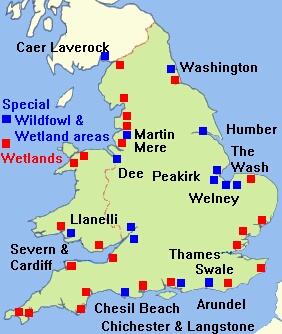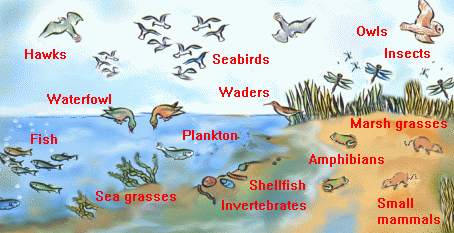Wetlands
 Wetland areas are varied. This is because the conditions between land and water can be different, whether stagnant, slow moving or fast moving, fresh water, salt water of brackish. So there can be estuary features, marshes, flooded peat areas and mangroves. The water table is high, and the water can cover the area all the time or by season.
Wetland areas are varied. This is because the conditions between land and water can be different, whether stagnant, slow moving or fast moving, fresh water, salt water of brackish. So there can be estuary features, marshes, flooded peat areas and mangroves. The water table is high, and the water can cover the area all the time or by season.
Around New Holland, and westwards, and north of the Humber too, the wetland feature is as usual elsewhere in Britain, where there are tidal movements and salt and fresh water meet.
Wetlands are their own small ecosystems with rich plant matter and a varied support for different plants, birds, insects and of course fish in the water. The fish enjoy protection and food, the birds can stay in winter and still feed.
Wetlands hold variable amounts of water quickly and so can prevent flooding elsewhere. They also work on pollution and filter sediment.
They have direct economic impact in ecological work, fish farming and tourism.
The Ramsar agreement (1971) of more than 60 countries promotes sustainable economic activity in wetlands including the creation of nature reserves, research, wetland management and ecological work. Where these areas come to international borders, co-operation is encouraged. The character of the sites should not change from this activity to benefit local people as well as the plants and wildlife. It is possible to put animals on to the land.
Nevertheless there is an ongoing threat to wetlands. For one thing, they silt up naturally. However, agriculture and human settlement can lower the water table and threaten the plant life and the rest of the ecology which depends on it for food and shelter. Agriculture is always tempted into wetlands because of the rich quality of the alluvial soil. Land can actually fall lower than the river or coast requiring corrective construction of land banks. Tourists bring money to an area but their boats stir up shallow areas and they can also bring disturbance. Changes in the sea level (eg from climate) could affect existing wetlands and create new ones.
In the Humber area ex-Clay pits provide water areas for birds, there are birdwatching sites (the number increasing) and the river itself provides shoreline wetland features.
 Wetland areas are varied. This is because the conditions between land and water can be different, whether stagnant, slow moving or fast moving, fresh water, salt water of brackish. So there can be estuary features, marshes, flooded peat areas and mangroves. The water table is high, and the water can cover the area all the time or by season.
Wetland areas are varied. This is because the conditions between land and water can be different, whether stagnant, slow moving or fast moving, fresh water, salt water of brackish. So there can be estuary features, marshes, flooded peat areas and mangroves. The water table is high, and the water can cover the area all the time or by season.